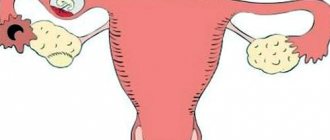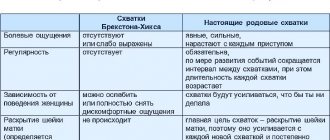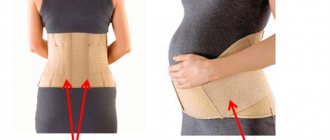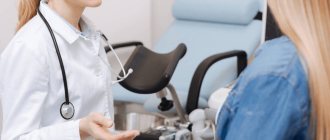Diseases that cause lower back pain and pulling in the lower abdomen
The nature of the pain can be completely different - from sharp cutting to moderate pulling. Each condition characterizes a particular disease. Delay in visiting a neurologist
It’s not worth it, because this is fraught with complications and the development of chronic diseases, which will make it very difficult to cure them. Among other things, some diseases that cause stomach and back pain cannot be delayed and require urgent, qualified help.
Appendicitis
Acute inflammation of the appendix is a condition in which the lower abdomen, lower back and back often hurt, and vomiting often occurs. The pain syndrome is sometimes so severe that the patient loses consciousness. Appendicitis requires urgent surgical intervention.
Oncological diseases
The reason for the pulling in the lower abdomen and lower back pain may be the development of a tumor. This is due to the fact that the tumor, growing, puts pressure on neighboring tissues, which is why pain occurs.
Intestinal infections
If you have an infection, pain in the abdomen and back will be accompanied by severe intestinal upset, and the presence of mucus and traces of blood will be noticed in the stool. This condition, in addition to pain, is characterized by intoxication of the body, weakness, vomiting and many other manifestations.
Diseases of the musculoskeletal system
Pain in the lower back, back and lower abdomen is often associated with diseases of the spine. When a person develops osteochondrosis, a hernia, scoliosis or other diseases, irradiation can occur in the stomach and throughout the back, which is explained by the plexus of nerves responsible for sending impulses to the muscles of the abdomen and lower back.
Symptoms of pyelonephritis in men and women
The structural features of the urinary system affect the course of pyelonephritis. Since women have a shorter urethra, it is easier for infection to reach the kidneys; pyelonephritis is often a consequence of untreated cystitis. Women more often suffer from kidney inflammation; the symptoms of pyelonephritis are more pronounced in them:
- rise in body temperature above 38 °C;
- characteristic features of general intoxication;
- change in the color of urine - up to a dirty yellow or darker color, and in case of urolithiasis and renal colic, there may be blood impurities in it.
Symptoms of pyelonephritis in men are often more subtle:
- thirst and dry mouth;
- general malaise;
- pain in the lumbar region.
Lower back pain and pulling in the lower abdomen in women
A woman’s body is subject to constant influence of hormones, changes in hormonal levels and some kind of “shocks”. Because of this, women often experience such an unpleasant symptom as pain in the lower abdomen on the left or right and in the lower back. It is worth understanding why pain may occur and what to do in this situation.
Diseases of internal organs
Diseases of the pelvic organs, for example, adnexitis ( inflammation of the appendages
), often accompanied by pain in the lower abdomen and lower back. Along with the pain, there is an increase in temperature and a deterioration in general well-being. The stomach and lower back can also be pulled due to infectious diseases such as colpitis, vulvitis, trichomoniasis, candidiasis, etc.
During menstruation
If during menstruation the lower abdomen and lower back hurt greatly, this does not necessarily indicate the presence of abnormalities. During menstruation, the uterus expands, which puts additional strain on the back muscles, and contractions of smooth muscles can cause the stomach to ache. To exclude the possibility of diseases manifesting in this way, you should consult a doctor, and if he is convinced that everything is in order, you can relieve pain during menstruation yourself with the help of analgesics.
Oncological diseases
Often an unpleasant symptom with pain in the abdomen and back overtakes women due to the development of oncology of the ovaries, uterus or cervix. To eliminate this possibility, you need to regularly visit a gynecologist.
for routine examinations, and also not to miss alarm bells from your body.
Ectopic pregnancy
Pain in the lower abdomen and back in the lumbar region often occurs if, after pregnancy, the fertilized egg ends up in the fallopian tube and not in the uterus. This phenomenon is not uncommon, and untimely contact with a doctor can cause a pipe rupture and the death of a woman. If your stomach and back hurt, and at the same time you have a delay, do not hesitate to visit a gynecologist!
Symptoms of acute pyelonephritis
The acute form of kidney inflammation manifests itself with striking symptoms:
- chills, loss of strength, general malaise, heavy sweating;
- the temperature can rise to 39-40 ° C;
- headaches, especially in the frontal part;
- nausea and vomiting are a consequence of general intoxication;
- muscle and joint pain scattered throughout the body;
- Sometimes changes occur in the gastrointestinal tract - diarrhea.
With obstructive pyelonephritis, it often begins with renal colic. Acute pain is followed by a rapid rise in temperature and deterioration in general condition. The person begins to sweat profusely, the temperature drops sharply, and a period of imaginary well-being begins. But if the cause of the obstruction of urine outflow is not eliminated, then over time more serious symptoms will appear, especially if we are talking about a purulent form:
- increased pain in the lumbar region;
- muscle tension in the lower back and anterior abdominal wall;
- the affected kidney enlarges, it is clearly felt upon palpation;
- dehydration;
- the patient’s facial features become sharper and their appearance changes;
- sometimes euphoria sets in.
Causes of pain in men
“It hurts in the lower abdomen, lower back and right side” - men often go to the doctor with such complaints. To understand what caused it, it is worth considering the cases in which such a symptom appears.
Prostatitis
Prostatitis
differs not only in that it pulls the lower back on the right and the stomach, but also in some other symptoms. For example, a man notes a burning sensation when visiting the toilet, as well as problems with erection. The cause of the disease is often stagnation of capillary blood, as well as the effect of bacteria on the body.
Bacterial infections
If unpleasant symptoms appear, when there is pain in the lower abdomen and lower back, the problem may lie in the penetration of pathogenic bacteria into the body. Bacteriological causes of pain are considered quite common. For example, stomach and back pain occur due to sexually transmitted diseases. In this case, a man may notice uncharacteristic discharge from the urethra, redness of the penis, impaired sexual function, etc.
Orchiepididymitis
It is an inflammation of the testicles, which can develop against the background of surgical interventions in the body, be a consequence of injuries or sexually transmitted diseases. In addition to abdominal and lower back pain, the man suffers from headaches, chills, nausea, and a fever.
Inguinal hernia
If the lower back hurts badly, and the pain radiates to the lower abdomen, and the pain itself is sharp and even unbearable, the cause may lie in an inguinal hernia. Sometimes hernia pain is even stronger than with appendicitis, and the patient has no choice but to call an ambulance.
Colitis
It is a pathology of the duodenum, or more precisely, an ulcer. The acute period of the disease lasts about a week, after which it becomes chronic, and the man constantly feels pain in the back and abdomen.
Diagnostics
The examination of the patient begins with the collection of complaints, examination and palpation of the abdominal cavity. A gastroenterologist must check the symptoms of peritoneal irritation to rule out acute surgical pathology. In addition to pain in the abdomen, the specialist often detects changes in blood pressure and pulse, which confirms the general serious condition of the person. To clarify the diagnosis, laboratory and instrumental methods are prescribed:
- Blood tests
. The hemogram reveals an increase in ESR and an increase in the level of leukocytes, regarded as signs of inflammation. Damage to the pancreas is indicated by an increase in the concentration of lipase and amylase; dyslipidemia and hyperglycemia are less common. With a biliary etiology of girdle pain, bilirubinemia and cholestasis syndrome are detected in the blood. - Urine and stool tests
. When examining urine, the presence of bilirubin and amylase is determined, which indicates damage to the pancreatic-hepatobiliary system. The level of fecal elastase is measured in the stool, which is a sensitive sign of pancreatic pathology that occurs with abdominal pain. - Ultrasound of the abdominal organs.
Ultrasound diagnostics is used to assess the condition of the pancreatic parenchyma, ducts, detect edema, infiltration, abscesses or other signs of damage. To establish the biliary causes of pancreatitis, an ultrasound scan looks at the liver and gallbladder. Sonography is also necessary to confirm a diaphragmatic hernia. - X-ray methods
. Plain radiography of the abdominal cavity is informative if organ perforation or other acute surgical conditions are suspected. CT visualizes the structure of tissues in detail, reveals space-occupying formations, and signs of an inflammatory process in the abdomen. - ERCP.
The technique is informative for visualizing the bile and pancreatic ducts and duodenal mucosa. ERCP helps in the diagnosis of tumor, obstructive and inflammatory diseases of the organ. For possible chronic duodenitis, EGD is performed.
If it is impossible to determine the causes of abdominal pain, diagnostic laparoscopy is used using standard methods. The surgeon examines the surface of the organ in detail, looking for foci of necrosis, inflammation or tumor decay. To diagnose non-digestive causes of pain, consultation with a neurologist with a complete physical examination and assessment of neurological status is recommended.
Ultrasound of the abdominal organs is a screening method for diagnosing the causes of girdle abdominal pain.
What to do in case of acute pain
When the lower abdomen and lower back hurt, we often start looking for reviews from other people who have already encountered such a situation in order to understand the reason and determine the course of action for ourselves. It is worth understanding that it is unlikely that you will be able to make an accurate diagnosis for yourself; here you need to immediately seek qualified help from specialists. If the pain is acute and sharp, it is best not to hesitate and call ambulance workers so that you can be examined and brought to the clinic as soon as possible for diagnosis and diagnosis. After this, you will be prescribed treatment, and you can expect an improvement in your condition.
Symptoms of chronic pyelonephritis
The chronic course is characterized by alternating acute phases and stages of remission. The active period will be characterized by the symptoms of acute pyelonephritis described above. And in the remission stage, a person may feel the following symptoms of chronic pyelonephritis:
- dull pain in the lower back;
- fatigue and lethargy;
- temperature rise to subfebrile levels;
- loss of appetite, nausea.
Without treatment, chronic renal failure occurs; a secondary wrinkled kidney becomes an ultrasound sign of chronic pyelonephritis. Another symptom of late-stage disease is high blood pressure.
Which doctor should I contact?
To find out the reasons why the lower back and stomach hurt, you need professional intervention, examination by a doctor and modern diagnostics. To understand who to contact, you should pay attention to the symptoms associated with pain. If, in addition to an aching stomach, there is discharge from the genitals and disruptions in the reproductive system, a gynecologist or andrologist will help you. For pain in the back and abdomen with numbness of the limbs, a neurologist should come to the rescue. If you are faced with such a problem for the first time, then the right solution would be to visit a therapist. His specialization will allow you to determine which specialist to refer you to for a detailed examination, diagnosis and treatment when your lower back, buttocks and lower abdomen hurt.
Causes of wandering pain
When all the muscles, bones and joints of the whole body hurt, the search for the causes begins with a visit to the doctor. But in order to know which doctor to go to, you need to take into account the presence of chronic diseases, previous infections or a predisposition to the development of various pathologies.
All provoking factors may be common and characteristic of a specific localization of the symptom. Most often, the causes of wandering pain throughout the body are systemic disorders and pathologies:
- physical overload and muscle strain;
- previous acute respiratory viral infections or infectious poisonings;
- postural disorders and spinal diseases;
- muscle inflammation due to hypothermia;
- constant stress and neuroses;
- various chronic diseases (diabetes mellitus, rheumatism, arthritis, etc.).
These are the most common causes of the symptom. It is possible to determine why the muscles of the whole body hurt only by conducting instrumental diagnostics and examination. Before going to the doctor, you need to assume a provoking factor that may cause pain. To do this, you need to take into account its localization and manifestations.











